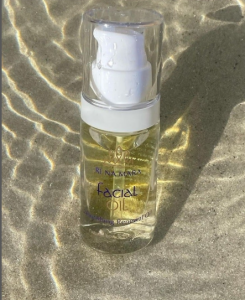In the timeless pursuit of radiant and healthy skin, we have cherished the well-being of our skin across generations. Whether self-care or overall well-being, the desire to moisturise and hydrate one’s skin remains steadfast. In this article, we will take a look into the nuance of skin care products with similar benefits, specifically exploring the distinction between facial serums and facial oils. Join us as we unravel the journey to a luminous complexion that resonates with the essence of clean beauty and the embrace of nature and discover the secrets to harmonizing with your skin’s natural beauty.
Facial Serum vs. Facial Oil: Understanding the Difference
Two products; facial serums, and facial oils, often find a place in many beauty routines. However, understanding the distinction between these products can help you make informed choices for your skincare regimen.
Facial Serum
Facial serums are water-based formulations designed to directly deliver a high concentration of active ingredients into the skin. These active components can include antioxidants, vitamins, peptides, and hyaluronic acid, among others. Serums are prized for their lightweight texture, allowing for quick absorption into the skin. One key feature of serums is their ability to address specific skin concerns, such as fine lines, dark spots, or dehydration. They work efficiently to target these issues due to their potent formulations. One popular contender is hyaluronic acid. This hydrating wonder ingredient permeates the skin to moisturise, hydrate and rejuvenate while ‘plumping’ and smoothing fine lines and wrinkles. Another little-known ingredient is Laminaria a brown kelp, containing vitamins, antioxidants, trace minerals, and polysaccharides, to form a protective outer surface on the skin. Laminaria stimulates Hyaluronic acid and boosts collagen production for a firming effect and cell renewal.
Infused with organic marine and plant extracts, Rí Na Mara’s Intensive regenerating serum immerses your skin with proteins, nutrients, and anti-oxidants stimulating hydration, and helping recharge your skin cells. If you’re looking to boost hydration, combat signs of ageing, or even out your skin tone, a facial serum might be a valuable addition to your routine. Serums are designed to be applied before moisturisers to deliver potent ingredients for maximum effectiveness.
Facial Oil
Facial oils, in contrast, are lipid-based products that provide an extra layer of moisture to the skin. These oils often contain natural ingredients like jojoba, argan, or rosehip oil. Rí Na Mara’s Intensive Renewal Facial oil contains organic Argan oil, Rosehip, Oat oil and a rich collection of natural oils to promote Collagen production helping soften the look of emerging lines and wrinkles while visibly firming skin. Skin’s natural barrier becomes more resilient. The potent anti-oxidant-rich formula deeply moisturises dry, mature skin. Soft and ultra-smooth, skin glows with new vitality.
The richness of facial oils makes them ideal for individuals with dehydrated skin. The primary function of facial oils is to lock in moisture, creating a protective barrier on the skin’s surface. This barrier helps prevent water loss, keeping the skin hydrated and supple. While some facial oils may include beneficial compounds, their main role is to nourish and moisturise the skin.
Choosing the Right Product for Your Skin
Deciding between a facial serum and a facial oil depends on your skin type, concerns, and the desired outcome. If you’re targeting specific issues like wrinkles or dark spots, a serum with potent active ingredients may be the answer. On the other hand, if your skin needs an extra dose of hydration and nourishment, a facial oil could be the perfect choice. In some routines, both serums and oils can complement each other. Applying a serum first to address specific concerns and following up with a facial oil to lock in moisture is a common practice. Remember, individual skin types vary, so it’s essential to observe how your skin responds to different products. Consider consulting with a dermatologist to create a personalized skincare routine tailored to your unique needs. Whether you opt for a facial serum, a facial oil, or both, understanding their roles can empower you to make choices that contribute to healthy, radiant skin.
Facial oil and facial serum serve distinct purposes in skincare:
Ingredients
Facial Oil: Primarily contains lipids, such as essential fatty acids and natural oils, to nourish and moisturize the skin
Facial Serum: Typically has a water-based formula with a higher concentration of active ingredients like antioxidants, vitamins, or peptides to target specific skin concerns.
Texture and Absorption
Facial Oil: Has a heavier, more emollient texture. It forms a protective barrier on the skin and is slower to absorb
Facial Serum: Generally has a lightweight, watery consistency that absorbs quickly into the skin without leaving a greasy residue.
Purpose
Facial Oil: Focuses on providing hydration and reinforcing the skin’s natural lipid barrier. Suitable for dry skin.
Facial Serum: Targets specific skincare concerns, such as anti-ageing, brightening, or acne, depending on the active ingredients.
Application Order
Facial Serum: Applied before moisturizer to deliver concentrated active ingredients directly to the skin.
Facial Oil: Typically applied as the final step in a skincare routine to lock in moisture.While facial oils and facial serums serve distinct purposes, they share some similarities:
Skincare Benefits
Both facial oils and serums aim to improve the overall health and appearance of the skin. They can also provide hydration and contribute to a smoother, more radiant complexion.
Concentration of Active Ingredients
Both products often contain concentrated active ingredients that target specific skincare concerns. While facial oils focus on lipids and moisturization, serums may include antioxidants, vitamins, peptides, or other targeted ingredients.
Customization
Both facial oils and serums allow for customization based on individual skin needs. Users can choose products with ingredients that address their specific concerns, whether it’s hydration, anti-ageing, or brightening.
Layering in Skincare Routine
Both are typically applied before moisturizer in a skincare routine to maximize their benefits. The order of application may vary, but they are generally used to deliver active ingredients before sealing in moisture.
Versatility
Facial oils and serums can be suitable for various skin types, depending on the formulation. They are versatile and can be integrated into different skincare routines. While they have commonalities, it’s important to note that their primary functions and formulations differ. Facial oils focus on providing moisture and lipids, while serums emphasize delivering targeted active ingredients for specific skincare concerns.
If you’re reading this sentence right here, you probably have a new working understanding of the difference between facial serum and facial oil. If not, if you skipped to the end. No bother, it’s the best part! How about understanding the difference by trying? Buy our Intensive regenerating and renewing Facial serum and Facial Oil today. We deliver worldwide! Celebrate 20 years of the gifts of the healing sea with us. All Rí Na Mara products incorporate the purest natural ingredients from marine or plant origin and are suitable for sensitive and all skin types.









CONNECT WITH US